
Aliacensis is a lunar impact crater that is located in the rugged southern highlands of the Moon. The crater Werner is located just to its north-northwest, and a narrow, rugged valley lies between the two comparably sized formations. To the southwest is Walther, and Apianus is to the northeast. Aliacensis is named after the 14th century French geographer and theologian Pierre d'Ailly in 1935. It is from the Nectarian period, which lasted from 3.92 to 3.85 billion years ago.
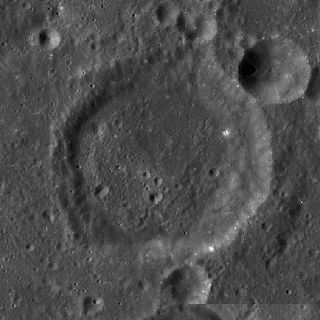
Almanon is a lunar impact crater that lies in the rugged highlands in the south-central region of the Moon. It was named after Abbasid Caliph and astronomer Al-Ma'mun. It is located to the south-southeast of Abulfeda, and to the north-northeast of the smaller crater Geber. The crater chain designated Catena Abulfeda forms a line between the south rim of Abulfeda and the north rim of Almanon, continuing for a length of about 210 kilometers to the Rupes Altai scarp.

Delambre is a lunar impact crater that lies to the southwest of Mare Tranquillitatis, in the central highland region. To the west is the crater pair of Theon Junior and Theon Senior, the latter being more distant and located to the northwest.
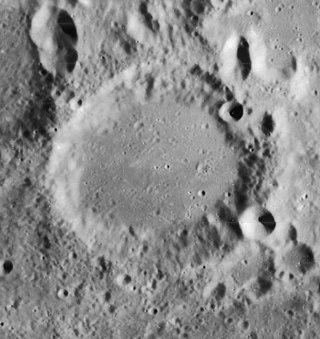
Apianus is a lunar impact crater that is located on the rugged south-central highlands of the Moon. It is named after 16th century German mathematician and astronomer Petrus Apianus. It is located to the northeast of the crater Aliacensis, and to the northwest of Poisson. The worn crater Krusenstern is attached to the west-northwestern rim.

Baco is a lunar impact crater that lies in the rugged southern highlands on the near side of the Moon. The rim and inner wall has been eroded and worn by countless minor impacts since the original formation of the crater. As a result, any terraces have been worn smooth and the rim is overlaid by several tiny craterlets. The interior floor is nearly flat, with no characteristic central peak at the midpoint and no small craters of significance.

Donati is a lunar impact crater that is located in the rugged south-central highlands of the Moon. It lies just to the northwest of the crater Faye, and the two outer rims are separated by a gap of less than 10 kilometers. To the north is the comparably sized Airy, and farther to the southeast is Playfair. Donati is 36 kilometers in diameter.
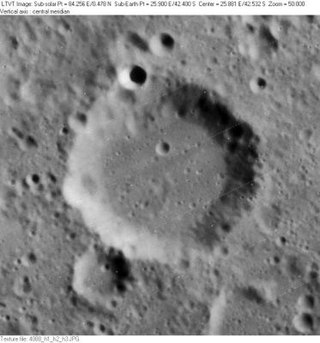
Nicolai is a lunar impact crater that is located in the southern hemisphere of the Moon, in a region that is less disturbed by significant impacts than most of the highlands. The nearest craters of note are Spallanzani to the south, and the much larger Maurolycus and Barocius to the east. The crater is named after the 19th-century German astronomer Friedrich Bernhard Gottfried Nicolai. It is 42 kilometers in diameter and reaches a depth of 1.8 kilometers.

Deluc is a lunar impact crater that lies in the southern highlands of the Moon. It is located to the south-southeast of the crater Maginus, and the huge Clavius. Due east of Deluc is the somewhat larger crater Lilius. It is 47 kilometers in diameter and 3.3 kilometers deep. It is from the Pre-Imbrian period, which lasted from 4.55 to 3.85 billion years ago.

Curtius is a lunar impact crater that is located in the southern part of the Moon. From the Earth the crater appears foreshortened, making it more difficult to observe detail. Nevertheless, this is a large crater that can be readily found in even small telescopes. Curtius is located within one crater diameter of the still-larger Moretus to the southwest. To the northeast is the smaller Pentland. Curtius is 95 kilometers in diameter and 6.8 kilometers deep. It is from the Nectarian period, 3.92 to 3.85 billion years ago.

Cannon is a lunar impact crater that is located near the east-northeastern limb of the Moon's near side. It lies just to the northwest of the Mare Marginis, and south-southeast of the crater Plutarch. Farther to the east-northeast is Hubble.

Jacobi is a lunar impact crater that is located in the southern highlands on the near side of the Moon. It lies southeast of the crater Lilius, with Cuvier to the north-northwest and Baco to the northeast. The crater is 68 kilometers in diameter and 3.3 kilometers in depth. It is from the Pre-Nectarian period, 4.55 to 3.92 billion years ago.

Mee is a lunar impact crater in the southwestern part of the Moon's near side. Overlying the northwestern rim and intruding one-third the distance across the interior floor is Hainzel, a merged triple-crater formation. To the south is the highly elongated crater Schiller. Mee is 132 kilometers in diameter and 2.7 kilometers deep. It is from the Pre-Nectarian period, 4.55 to 3.92 billion years ago.

Licetus is a lunar impact crater on the near side of the Moon, in the rugged southern highland region. It lies to the south of the walled plain Stöfler, and is attached to the northern rim of the sub-divided crater Heraclitus. Just to the southeast is Cuvier. Licetus is 75 kilometers in diameter and 3.8 kilometers deep. It is from the Pre-Nectarian period, 4.55 to 3.92 billion years ago.
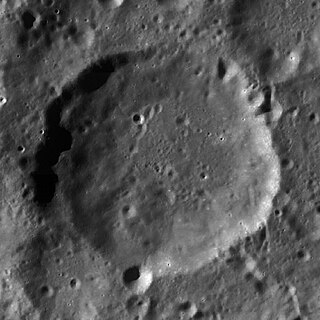
Clark is a lunar impact crater that lies in the southern hemisphere of the Moon's far side. It is located midway between the larger walled plain Van der Waals to the south and the similar-sized crater Pizzetti to the north. It is named for American astronomer and telescope maker Alvan Clark and his son Alvan Graham Clark.

Dyson is a lunar impact crater, 63 kilometers in diameter, that lies on the far side of the Moon, past the northwest limb. It is located in the northern part of the surface, to the northwest of the crater Coulomb, and east of van't Hoff.

Nearch is a lunar impact crater that is located in the southeastern part of the Moon, to the southeast of the crater Hommel. North of Nearch is Vlacq, and to the northeast lies Rosenberger. The crater is 76 kilometers in diameter and 2.9 kilometers deep. It is from the Pre-Nectarian period, 4.55 to 3.92 billion years ago.
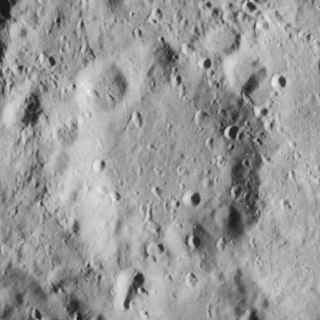
Proctor is the remnant of a lunar impact crater that is located to the southeast of the prominent crater Tycho. It lies just to the north of the huge walled plain Maginus. To the north is the crater Saussure and to the northwest, just to the east of Tycho, lies Pictet. Proctor is 52 kilometers in diameter and its walls are 1,300 meters high. It is from the Pre-Imbrian period, which lasted from 4.55 to 3.85 billion years ago.

Kinau is a small, eroded lunar impact crater that is located in the low southern latitudes of the Moon. It lies to the southeast of the crater Jacobi, and about equally far to the north-northwest of Pentland. It is 42 kilometers in diameter and two kilometers deep. It may be from the Pre-Nectarian period, 4.55 to 3.85 billion years ago.

Dreyer is the remnant of a lunar impact crater on the far side of the Moon. It is located along the eastern edge of the Mare Marginis, about midway between the craters Ginzel to the north and Erro to the south-southeast. It was named after Danish-Irish astronomer John L. E. Dreyer.

Seyfert is a prominent lunar impact crater that is located on the far side of the Moon. It was named after American astronomer Carl Keenan Seyfert. It lies behind the eastern limb of the Moon, to the east of the crater Espin. Just to the north of Seyfert is the crater Harriot and equally close to the south is Polzunov.




















